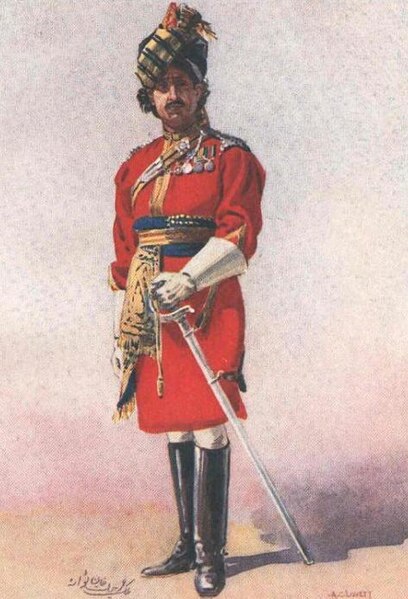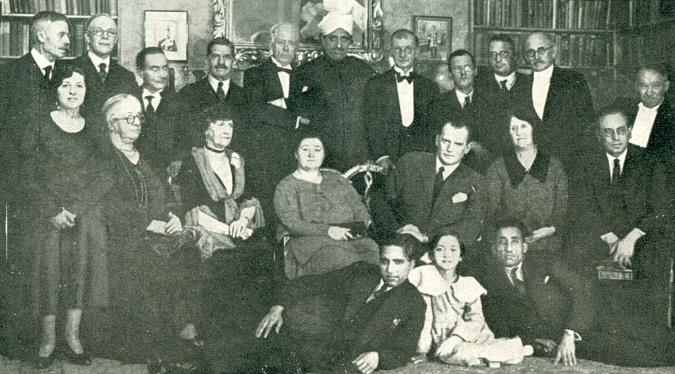
Major General Nawab Sir Malik Mohammed Umar Hayat Khan GBE KCIE MVO (1875–1944), was a soldier of the Indian Empire, one of the largest landholders in the Punjab, and an elected member of the Council of State of India. He was also called Sir Malik Umar Hayat Khan Tiwana.
Background and early life
The son of Sir Malik Sahib Khan KB CSI, Khan belonged to a Rajput family which had been prominent among the landed aristocracy of the Punjab since the 15th century, and was educated at Aitchison Chiefs College, Lahore.
Centre background: Colonel Nawab Sir Umar Hayat Khan
Back row (left to right): C.D. Locock, R.H.S. Stevenson, P.W. Sergeant, C. Wreford-Brown, Sir Ernest Graham-Little, M.P., R.C. Griffith, F.D. Yates, J. du Mont, A. Rutherford, J.B. Whieldon
Next row: Miss Joseph, Mrs Latham, Mrs Arthur Rawson, V. Menchik, A. Alekhine, Mrs Stevenson, J.A. Seitz.
Foreground: S. Basalvi, Aziz, Mir Sultan Khan.
Back row (left to right): C.D. Locock, R.H.S. Stevenson, P.W. Sergeant, C. Wreford-Brown, Sir Ernest Graham-Little, M.P., R.C. Griffith, F.D. Yates, J. du Mont, A. Rutherford, J.B. Whieldon
Next row: Miss Joseph, Mrs Latham, Mrs Arthur Rawson, V. Menchik, A. Alekhine, Mrs Stevenson, J.A. Seitz.
Foreground: S. Basalvi, Aziz, Mir Sultan Khan.
Career
Military service
Khan served in the Somaliland War of 1902-1904, receiving the Jidballi medal and clasp, in the Tibet Expedition of 1903-1904 (for which he was Mentioned in Despatches), in the European theatre of the Great War, 1914-15 (during which he was Mentioned in Despatches a further six times), and then in the Third Anglo-Afghan War. He was attached to the 18th King George's Own Lancers and later the 19th King George's Own Lancers.He acted as an honorary aide-de-camp to George V, Edward VIII, and George VI
Public life
In 1907, moving beyond his career as a soldier, the management of his family estates in the Punjab, and his role as an hereditary Provincial Darbari, Khan became an Attaché to HM the Amir of Afghanistan. He served as a member of the Governor-General of India's Imperial Council from 1910 to 1944.In 1910, in the Imperial legislature, Khan called for Europeans to supervise districts as "...disinterested men to safeguard the interests of all".
In December 1913, he was elected as one of the seventeen officers of the All India Muslim League, at the League's Seventh Session held at Agra.
He was a member of the Council of the Secretary of State for India from 1924 to 1934, as well as becoming an elected member of the Council of State and a member of the Punjab Legislative Council for two terms.
In a deposition for a case in the High Court in 1924, Khan was described as "Colonel Sir Malik Umar Hayat Khan Tiwana KCIE, CEI, MVO, Zamindar of forty-eight thousand bighas at Shapur, Rawalpindi, Honorary Magistrate 1st Class".
From 1929 to 1934, he spent most of his time in London, joining the conservative Carlton Club and becoming President of the British Falconers' Club.
Herald
At the Delhi Durbar of 1911, Khan acted as Assistant Herald to Brigadier General William Peyton, the Delhi Herald Extraordinary.Umar Hyat acquired Shahpur lands of Sherazi Syeds of Shahpur with the help of British revenue department as a result of his military recruitment efforts for the British army.Sherazi Syeds of Shahpur had that land since Mughal era.
The O'Dwyer - v. - Nair libel case
In 1924, Khan appeared as a significant witness in the O’Dwyer - v - Nair libel case, heard in the High Court in London over five weeks from 30 April 1924.Sir Michael O’Dwyer, Lieutenant-Governor of the Punjab until 1919, sued Sir Chettur Sankaran Nair in a case concerning matters arising from the Amritsar Massacre and the Punjab Disturbances of 1919, and in particular recruiting abuses in the Punjab between 1917 and 1918. The case turned into one of the longest civil hearings in English legal history up to that time.
Khan, appearing as a witness for O'Dwyer, stated that there had been a recruiting quota, namely one third of all villagers of military age. He described the killing of Tahsildar Sayyad Nadir Hussain in Lakk by villagers who strongly objected to his approach to recruiting, and an attack by one thousand rioters on police seeking to enforce recruitment warrants, resulting in the killing of some of the rioters. Under cross examination, he admitted that there had been a 'white book' and a 'black book', in which village headmen who met recruitment targets and those who did not were listed.
O'Dwyer won his case, with the sole dissenting member of the jury being the political philosopher Harold Laski.
Private life
Khan married and had one son, Sir Malik Khizar Hayat Tiwana KCSI, OBE (1900–1975), who served as Chief Minister of the Punjab from 1942 until 1947.He performed the Haj pilgrimage in 1935.
Khan gave his recreations in Who's Who as "motoring, polo, pig-sticking, riding, shooting, athletics, hawking, coursing".
Among his manservants was Mir Sultan Khan whose chess ability was recognized by Umar Khan. Therefore, he took Sultan Khan with him to England. During Umar Khan's stay in Europe, Sultan Khan became indeed one of the world's strongest chess players.
Honours
- Honorary Lieutenant in the Indian Army, 1901
- Jidballi medal and clasp, 1903
- Delhi Durbar (1903) medal, 1903
- Companion of the Order of the Indian Empire, 1906 King's Birthday Honours
- Honorary Captain in the Indian Army, 1911
- Delhi Durbar (1911) medal, 1911
- Member of the Royal Victorian Order, Fourth class, 1911
- Knight Commander of the Order of the Indian Empire, 1916
- Honorary Major in the Indian Army, 1917
- Commander of the Order of the British Empire, 1919 King's Birthday Honours
- Honorary Lieutenant-Colonel in the Indian Army, 1920
- Nawab (hereditary), 1929
- Honorary Colonel in the Indian Army, 1930
- Knight Grand Cross of the Order of the British Empire, 1934 King's Birthday Honours
- Honorary Major General, Indian Army, 1935
- Honorary Colonel of 18th King George's Own Lancers
- Honorary Extra Aide-de-camp to George V, 1930
- Honorary Extra Aide-de-camp to Edward VIII, 1935
- Honorary Extra Aide-de-camp to George VI, 1936 to 1944
- Honorary Magistrate (first class)
- President of the British Falconers' Club

No comments:
Post a Comment